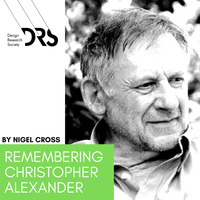
Christopher Alexander, who died on 17 March 2022 at the age of 85, was one of the pioneers of the design methods movement. His paper on ‘The Determination of Components for an Indian Village’ at the 1962 Conference on Design Methods in London attracted a great deal of attention for its rational approach to combining problem requirements into solution structures. The paper was drawn from research for his Doctoral thesis at Harvard University (the first PhD in Architecture there), in which he developed a computer-based method of hierarchical decomposition of a set of problem requirements in urban design. The book of his thesis, ‘Notes on the Synthesis of Form’ (1964) became very influential in design theory and methods.
However, by 1971 Alexander appeared to have become disillusioned with design methods. In an interview published in the Design Methods Group Newsletter he said of design methodology, “I would say forget it, forget the whole thing.” He claimed that his original motive for getting involved with design methods was because he wanted to design beautiful buildings – as good as traditional, vernacular architecture. Influenced by his background in mathematics as well as architecture (he studied both at Cambridge University, UK) he had wanted to be able to describe a logical, step-by-step process for design to ensure that he really knew what he was doing: “the definition of a process, or a method, was just a way of being precise, a way of being sure I wasn’t just waffling”.
His most influential work ‘A Pattern Language’ (1977) is a large book (regarded as a ‘bible’ by both supporters and detractors) of 253 individual patterns for architectural and urban design. Each pattern describes an often-encountered problem or issue, and a solution for resolving it, backed with an explanatory statement that may be based sometimes on empirical evidence but other times on anecdotal observation. It was intended as a means to help anyone to be able to design buildings for themselves or with their communities. Alexander applied the pattern language in a wide variety and large number of architecture and planning projects, and although it was strongly criticised by some within architecture it became widely used elsewhere, especially in software design. In later work, he continued to pursue an interest in the structure of living systems and how to create life-enhancing environments with a series of books on ‘The Nature of Order’ (2004), encompassing a theory of wholeness and harmony as a basis for architecture and planning.
Although he apparently refuted design methods, Christopher Alexander remained a very successful and influential, if controversial, developer, practitioner and theorist of design methods. He was a Professor of Architecture at the University of California from 1963 to 1998, and subsequently Emeritus Professor.
-- Nigel Cross
Photo: Michaelmehaffy - Own work, CC BY-SA 4.0, https://commons.wikimedia.org/w/index.php?curid=47871494
